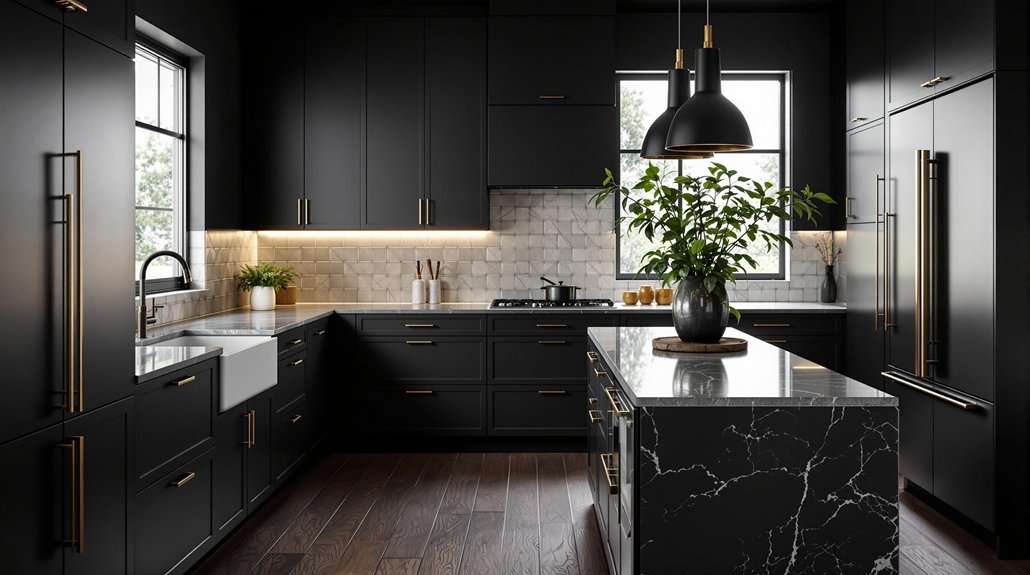
20 Black Kitchen Aesthetic Ideas That Feel Moody and Modern
Black kitchen aesthetics create a striking yet modern atmosphere through deep matte cabinetry, high-contrast surfaces, and dramatic stone or marble accents. Strategic lighting—both natural and artificial—prevents visual heaviness while brass, wood, and exposed brick amplify tactile contrast. Glossy and matte finishes, layered textures, and bold color pops add spatial definition. Industrial and farmhouse elements enhance warmth and character, balancing shadow and luminosity. Explore how these design concepts transform kitchen environments into sophisticated, moody spaces.
Key Takeaways
- Pair matte black cabinetry with light countertops and gold hardware for dramatic contrast and modern sophistication.
- Combine glossy black backsplashes with exposed brick or concrete to create bold textural and visual depth.
- Incorporate large windows and layered lighting to brighten black kitchens and prevent a heavy, enclosed feel.
- Add rustic wood accents, such as reclaimed beams or shelving, to introduce warmth and soften black surfaces.
- Use bold-veined marble backsplashes and brass fixtures for a luxurious, moody, and contemporary kitchen statement.
Traditional Black Cabinetry
Traditional black cabinetry establishes a visually commanding focal point within the kitchen, utilizing deep, saturated finishes to enhance spatial depth and sophistication. This cabinetry type introduces a timeless element, seamlessly integrating with both classic and modern black design schemes. The application of traditional black cabinetry increases perceived depth, with matte or gloss surfaces reflecting or absorbing ambient light to accentuate contrast. Paired with light countertops or backsplashes, the cabinetry’s silhouette becomes sharply defined, reinforcing the kitchen’s architectural lines. Integrated sinks offer a seamless appearance, reducing visual clutter for a clean design. Versatility is achieved through strategic material pairings—gold hardware or rustic wood accents infuse additional texture and visual interest. When juxtaposed against white walls or light fixtures, traditional black cabinetry preserves a balanced, modern black aesthetic while maintaining an enduring sense of elegance and luxury within the spatial composition.
Moody Charcoal Accents
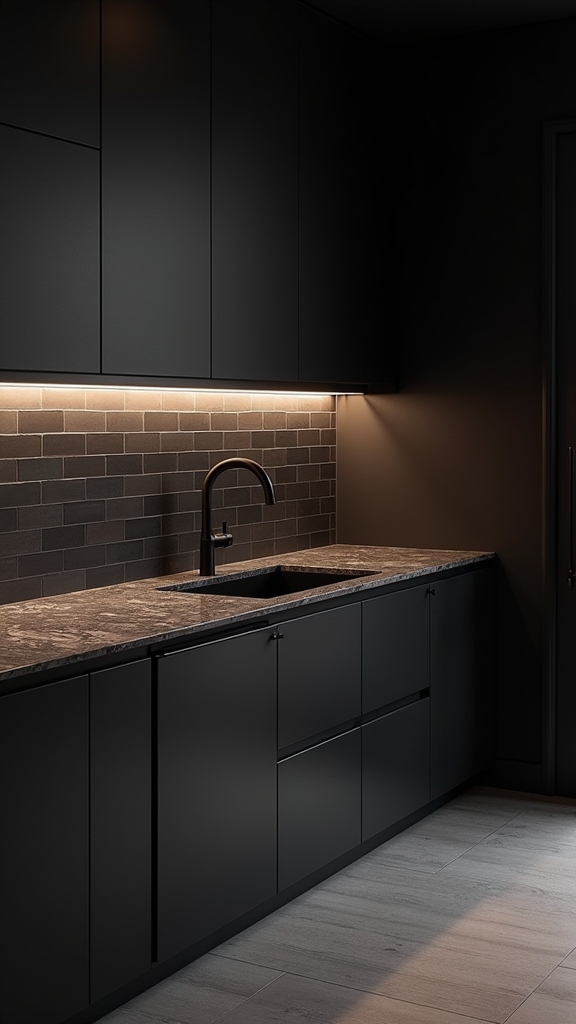
Moody charcoal accents introduce a versatile color spectrum, ranging from soft graphite to deep slate, that adapts to both modern and classic kitchen layouts. Strategic placement of large windows and statement lighting counteracts the visual density of dark surfaces, optimizing ambient brightness and spatial openness. This combination amplifies warmth and comfort, achieving a balanced interplay between shadow and illumination. Introducing black granite countertops with gold veining can add a touch of luxury and modernity to the kitchen design.
Versatile Charcoal Color Palette
A spectrum of charcoal tones introduces a deep, sophisticated alternative to lighter palettes, establishing a visually impactful foundation in kitchen design.
The versatile charcoal color palette is particularly effective when applied to black cabinetry, offering a seamless shift between gray and jet-black surfaces. This nuanced gradation enhances spatial perception, contributing to a moody kitchen ambiance that feels both modern and inviting.
Charcoal accents, such as matte-finished countertops or textured backsplash tiles, provide visual depth and tactile interest. The adaptability of these shades allows designers to integrate complementary materials—like brushed brass hardware or natural wood shelving—without overwhelming the space.
Charcoal’s inherent richness anchors the kitchen, ensuring the atmosphere remains grounded, cohesive, and layered, while maintaining a bold, contemporary edge.
Enhancing Light and Warmth
Building on the depth established by a charcoal color palette, enhancing light and warmth within a moody kitchen environment requires strategic interventions.
Integrating large windows maximizes natural light penetration, counterbalancing the absorptive qualities of dark hues and creating a visually expansive spatial effect. Layered artificial lighting, including wall sconces and statement fixtures, introduces targeted luminance, mitigating shadow zones and providing a controlled, ambient glow.
The juxtaposition of warm wood—such as walnut cabinetry or oak shelving—against charcoal surfaces introduces tactile warmth and organic visual relief. Light wood flooring or accent details further amplify reflectivity, ensuring the space avoids visual heaviness.
Textured materials, including fluted cabinet doors or stone countertops, enhance depth, yielding a dynamic, harmonious interplay between moody sophistication and welcoming luminosity.
Rustic Farmhouse Elements
When natural wood accents such as open shelving or butcher block countertops are introduced into a black kitchen, the interplay of organic texture against dark cabinetry establishes both warmth and visual contrast. This spatial strategy is central to the rustic farmhouse aesthetic, where matte black cabinets juxtapose reclaimed wood beams or flagstone flooring. The technical integration of vintage-inspired fixtures, such as an apron-front sink, adds authenticity, while modern appliances guarantee contemporary functionality. Decorative elements—ceramic pottery or greenery—can be strategically placed to soften the visual weight of black cabinetry. The resulting environment achieves a harmonious balance between modernity and rusticity, defined by tactile diversity and spatial layering. Mixing textures such as wood, stone, and metal in the kitchen creates a dynamic space, enhancing both depth and warmth.
| Element | Material | Purpose |
|---|---|---|
| Open Shelving | Natural Wood | Display, Warmth |
| Black Cabinets | Matte Finish | Modern Contrast |
| Butcher Block | Solid Wood | Texture, Functionality |
| Reclaimed Beams | Distressed Timber | Character, Structure |
| Ceramic Pottery | Glazed Earthenware | Softness, Decoration |
Industrial Style Details

Shifting from rustic farmhouse warmth to a more utilitarian aesthetic, industrial style in black kitchens is defined by the interplay of hard surfaces and architectural geometry.
Black cabinetry, especially in the Shaker profile, anchors the visual field with bold linearity, juxtaposed against the crisp repetition of white subway tile. Exposed brick walls introduce tactile contrast, infusing character while maintaining cohesion with the dark palette.
Shaker-style black cabinetry and white subway tile form striking lines, while exposed brick walls add tactile contrast to the kitchen’s dark palette.
Stainless steel elements—appliances and streamlined hardware—supply reflective accents, counterbalancing the depth of black surfaces and enhancing spatial clarity.
Overhead, black pendant lighting with industrial contours casts focused illumination, intensifying the room’s moody undertone.
The integration of raw materials, such as concrete countertops and metal accents, articulates the industrial style’s emphasis on structural authenticity and spatial composition within the black kitchen environment. Incorporating metallic accents such as chrome or brass finishes can further enhance the glamour and sophistication of the space.
Light-Filled Black Spaces
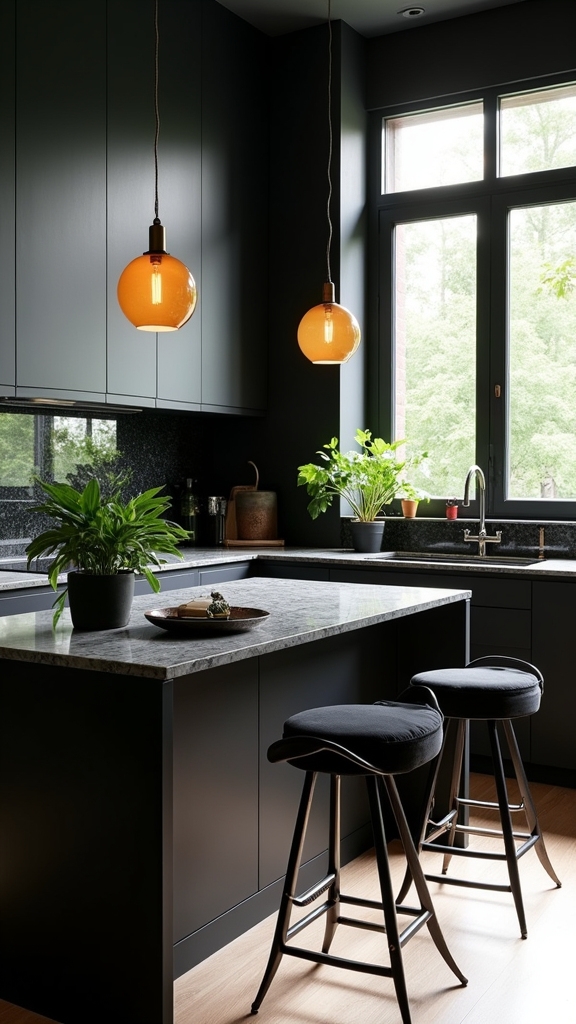
Light-filled black kitchens achieve spatial equilibrium by maximizing natural light through expansive fenestration and strategic window placement.
The integration of reflective surfaces, such as high-gloss cabinetry and metallic accents, increases luminance and mitigates visual heaviness.
This approach fosters a dynamic interplay between dark finishes and ambient brightness, resulting in an inviting and visually balanced environment.
Maximizing Natural Light
Although black kitchens are often associated with moody sophistication, maximizing natural light within these spaces is a matter of spatial planning and material selection.
Strategic integration of expansive windows or glass doors proves crucial in illuminating dark cabinetry, mitigating any sense of enclosure. The juxtaposition of pale wood or light-colored tile flooring against black kitchen elements not only enhances visual depth but also amplifies light diffusion.
Open shelving and glass-front cabinets serve dual purposes: promoting light penetration and expanding perceived space, thus counteracting the density of darker hues.
Layered lighting solutions—such as under-cabinet illumination and pendant fixtures—work in tandem with natural daylight to guarantee consistent brightness and functionality.
Successful maximizing of natural light, consequently, hinges on deliberate architectural choices and sensitive material contrasts within black kitchens.
Reflective Surfaces for Brightness
Glossy finishes and reflective surfaces play a pivotal role in optimizing luminosity within black kitchen environments. Employing high-gloss tiles, polished stone countertops, and metallic hardware counteracts the visual weight of dark cabinetry, producing a light-flooded effect characteristic of a modern kitchen. Strategic introduction of mirrors or glass not only amplifies available light but also augments spatial depth. Open shelving with glassware or pale ceramics punctuates the darkness, maintaining visual continuity while enhancing brightness. Layered illumination—from pendant fixtures to under-cabinet LED strips—synergizes with reflective surfaces to guarantee an inviting, balanced atmosphere.
| Reflective Element | Primary Function | Visual Effect |
|---|---|---|
| Glossy Tiles | Light Distribution | Enhanced Surface Shine |
| Polished Metal Hardware | Light Refraction | Modern, Sleek Accents |
| Glass Shelving | Depth & Openness | Visual Lightness |
| High-Gloss Countertops | Surface Reflection | Luminous Workspaces |
Strategic Window Placement
When strategically integrated, window placement transforms black kitchens by channeling ample natural light into otherwise saturated spaces.
The careful orientation and scale of windows—such as large arched or floor-to-ceiling installations—introduce visual relief and serve as luminous focal points, offsetting the depth of black cabinetry and countertops.
Skylights supply overhead illumination, ensuring even moody designs remain inviting and spatially expansive.
Ideal window placement, particularly those framing outdoor vistas, fosters a sense of continuity with exterior environments, mitigating any potential for the kitchen to feel closed-in or oppressive.
Additionally, situating reflective materials like glass or polished metal adjacent to windows amplifies incoming sunlight, enhancing the spatial perception and dynamic ambiance.
Strategic window design is consequently pivotal in achieving a balanced, modern black kitchen aesthetic.
Exposed Brick Contrasts
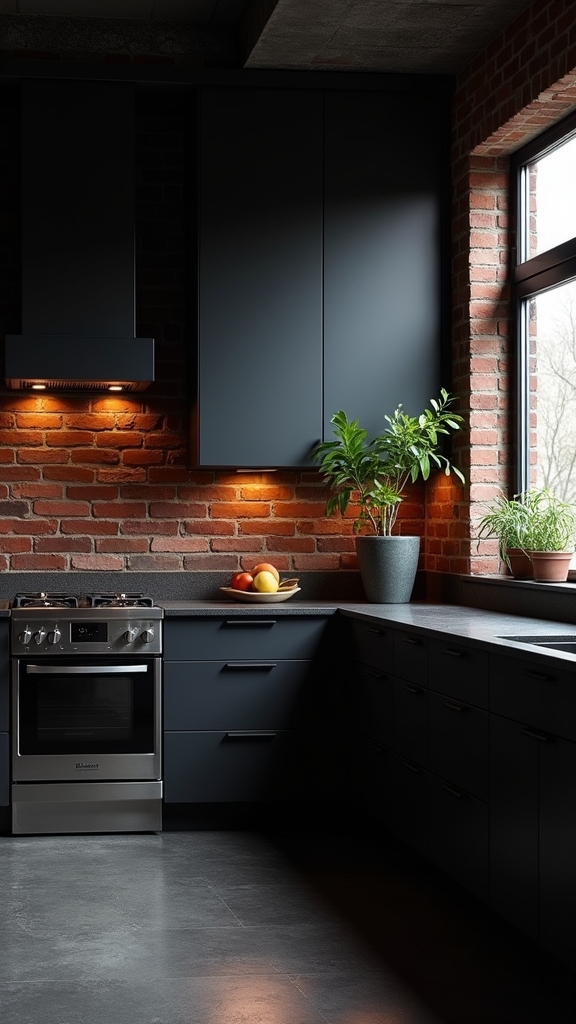
Exposed brick serves as a tactile focal point within black kitchen designs, establishing a pronounced visual contrast that amplifies spatial depth and architectural character.
The juxtaposition of sleek black cabinetry against the textured irregularity of exposed brick introduces a nuanced interplay between contemporary and rustic aesthetics. This arrangement leverages the inherent warmth and organic variation of brickwork to counterbalance the cool, monolithic presence of black cabinetry.
Employing black Shaker cabinets accentuates the linearity and formality of the kitchen’s structure, while the rough-hewn brick provides visual relief and dimensionality. Integration of polished concrete or dark countertops further heightens the industrial undertones, fostering a cohesive and edgy environment.
Strategic lighting accentuates the tactile differences, casting dynamic shadows that contribute to the overall moody ambiance and spatial complexity.
Chalkboard Wall Features
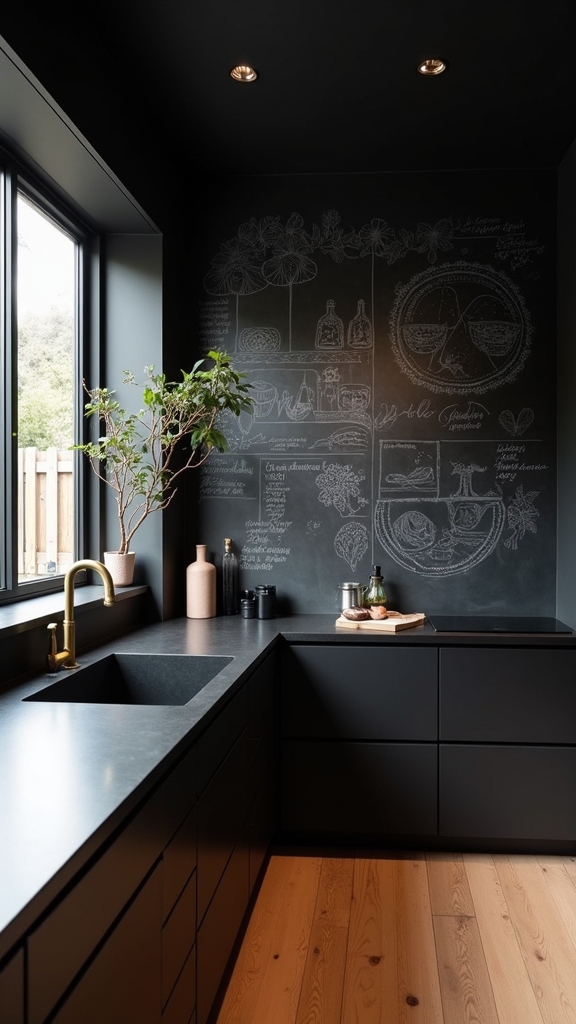
A chalkboard wall introduces multifunctional surface utility, serving as an interactive family message board within the black kitchen layout.
This design choice supports a dynamic DIY accent feature, allowing for continuous visual transformation and user-driven customization.
When integrated alongside vintage décor elements, the matte finish and bold contrast reinforce spatial cohesion and historical texture within the contemporary kitchen zone.
Family Message Board Functionality
Chalkboard wall integration in a black kitchen introduces a dynamic communication surface, functioning as a centralized family message board. This spatial solution leverages matte or satin chalkboard paint finishes, harmonizing seamlessly with the dark, moody palette of a black kitchen.
Positioned strategically—often by entrances, prep zones, or near the refrigerator—the chalkboard wall provides immediate accessibility for jotting down reminders, grocery lists, or schedules. Its interactive plane fosters engagement, transforming routine communication into a visually stimulating process.
The customizable nature of chalkboard paint accommodates various design intents, ensuring cohesion with the kitchen’s overall aesthetic. With regular surface maintenance, the chalkboard wall retains a crisp, inviting appearance, enhancing operational efficiency and adding visual intrigue to the heart of the home.
Creative DIY Accent Wall
Many contemporary black kitchens benefit from the integration of a DIY accent wall utilizing chalkboard paint, introducing a tactile, matte surface that delivers both visual contrast and user interaction.
The incorporation of a chalkboard wall serves as both a practical and aesthetic solution, creating a dynamic focal point within the dark, cohesive environment of a black kitchen. Chalkboard paint enables continuous customization, offering a versatile backdrop for grocery lists, recipes, or spontaneous sketches.
This layer of texture and visual interest disrupts the uniformity of dark cabinetry, reinforcing the moody ambiance while remaining cost-effective and accessible for homeowners. The spatial placement of the chalkboard wall—adjacent to prep areas or entryways—maximizes utility and enhances the modern, personalized atmosphere.
- Deep matte finish
- High-contrast textural surface
- Everyday functionality
- Seamless integration with cabinetry
- Easily updatable artwork
Mixing Vintage Decor Elements
Integrating vintage decor elements alongside a chalkboard wall introduces a layered interplay of eras within the black kitchen environment.
The matte expanse of the chalkboard wall delivers a tactile, visually striking contrast against the reflective or satin sheen of black cabinetry. Distressed, reclaimed cabinet doors reinforce the vintage narrative, their patina and weathered surfaces juxtaposing the clean lines and deep hues of contemporary finishes.
Industrial vintage stools, with aged metal and worn leather, punctuate the spatial composition, adding both functionality and nostalgic texture.
The chalkboard wall itself operates as a mutable design feature, displaying seasonal motifs, handwritten recipes, or schedules, enhancing the kitchen’s dynamic utility.
This synthesis bridges the gap between modern minimalism and the warmth of vintage aesthetics, cultivating a cohesive, moody ambiance.
Natural Wood Pairings
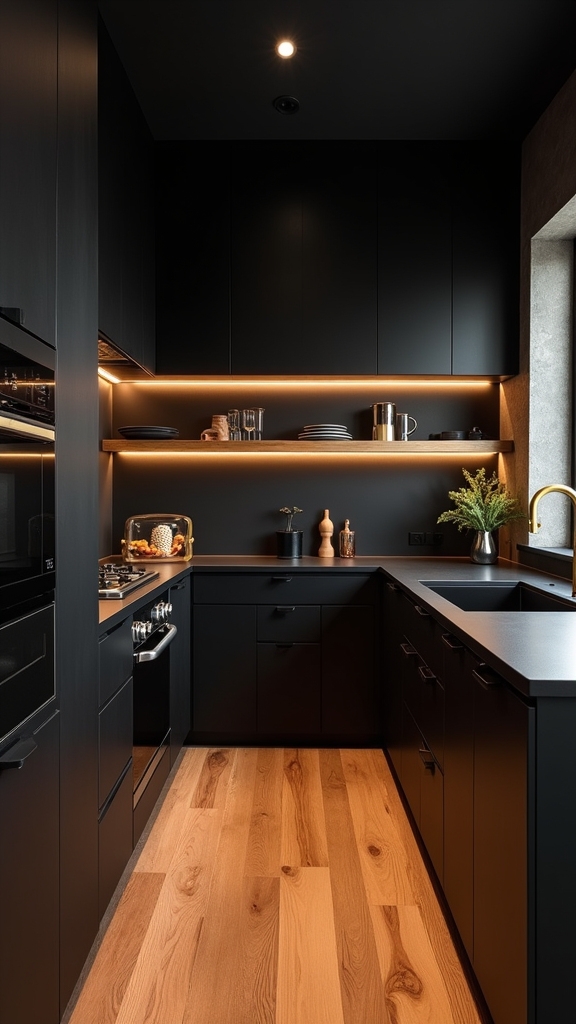
A juxtaposition of black cabinetry and natural wood elements establishes a visually compelling focal point in kitchen design. This dynamic contrast leverages the depth of black finishes with the warmth and texture of natural wood, producing a space that is both modern and inviting.
Utilizing timber-clad islands or oak shelving introduces spatial layering, while walnut worktops infuse tactile richness. The strategic placement of rustic wooden beams can break up the expanse of black cabinetry, lending an organic, lived-in character. Sustainable materials champion eco-friendly design ethos, emphasizing a connection with nature.
Timber-clad islands and walnut worktops add richness, while rustic beams soften black cabinetry with inviting, organic texture.
Such pairings not only anchor the kitchen visually but also harmonize with botanical accents, reinforcing an earthy, grounded ambiance.
- Black cabinetry framed by floating oak shelves
- Timber-clad kitchen islands with integrated storage
- Walnut countertops for tactile and visual warmth
- Rustic wooden beams accentuating ceiling architecture
- Natural wood open shelving supporting greenery displays
Matte and Glossy Finish Mixes
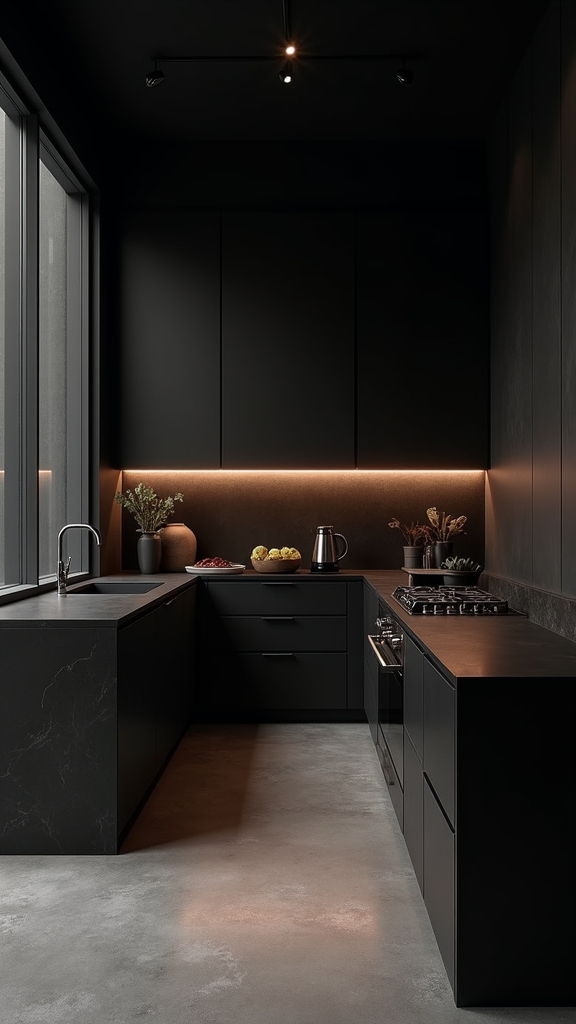
Juxtaposing matte cabinetry with glossy surfaces introduces a heightened interplay of light and texture within the kitchen environment.
This strategic contrast amplifies spatial dynamics, creating layered visual depth that guides the eye across different zones.
The resulting tactile variation enhances both functional clarity and aesthetic sophistication.
Contrasting Surface Textures
Surface texture differentiation within a black kitchen aesthetic relies on the deliberate interplay of matte cabinetry and glossy tile backsplashes, establishing visual hierarchy and spatial depth.
Matte black cabinetry introduces a tactile, absorptive quality that grounds the spatial composition, while glossy black surfaces—such as tile or countertops—amplify reflected light and highlight architectural lines.
This combination not only accentuates the moody ambiance but also orchestrates a dynamic balance between light absorption and diffusion.
Brushed metal hardware punctuates the matte and glossy juxtaposition, introducing a subtle metallic sheen.
Delineation of kitchen zones is enhanced by this contrast, fostering a sense of cohesion within the modern framework.
- Matte black cabinets as foundational surfaces
- Glossy black backsplashes reflecting ambient light
- Brushed metal taps and handles for tactile contrast
- Shadow play enhancing spatial definition
- Visual segmentation of prep and cook zones
Layered Visual Depth
Building upon the interplay of contrasting surface textures, layered visual depth emerges through the strategic combination of matte black cabinetry and high-gloss finishes.
Matte black cabinets absorb ambient light, establishing a subdued, elegant foundation within the spatial composition. In contrast, glossy finishes—such as reflective backsplash panels or lacquered surfaces—introduce light-reflective focal points that activate the kitchen’s visual rhythm.
This juxtaposition not only accentuates the dimensional boundaries between surfaces but also delineates functional zones, enhancing spatial clarity. Integrating additional elements, like brushed metal taps, further amplifies the textural hierarchy and creates a sophisticated tactile experience.
The balanced orchestration of matte and glossy finishes cultivates a visually compelling environment, reinforcing both the modern aesthetic and the inviting atmosphere characteristic of a well-designed black kitchen.
Dramatic Marble Backsplashes
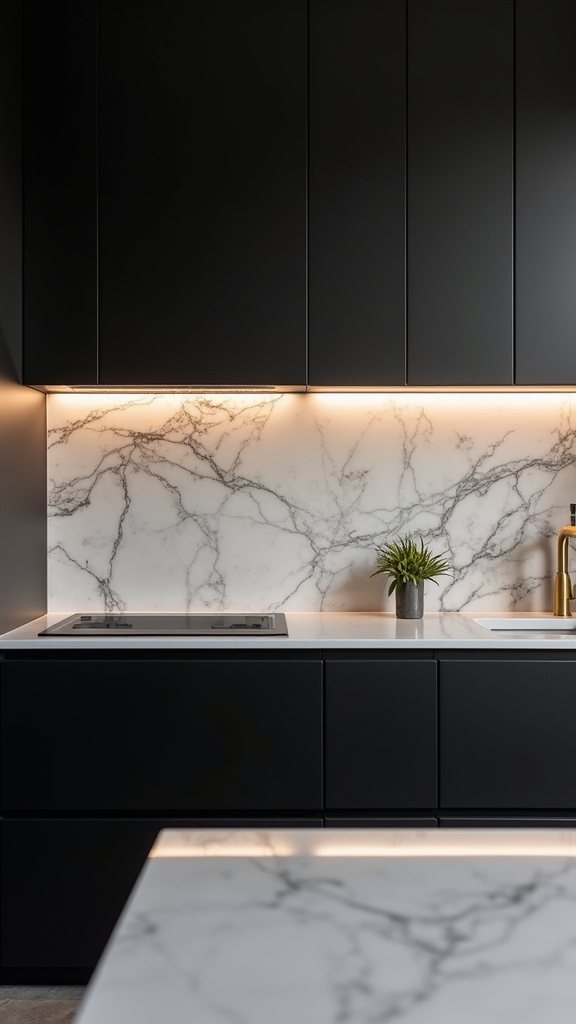
When integrated into a black kitchen, dramatic marble backsplashes—characterized by pronounced veining and a polished finish—serve as visually commanding elements that establish spatial hierarchy.
The interplay between dramatic marble backsplashes and black cabinetry creates a sophisticated contrast, intensifying the moody ambiance while ensuring each surface retains its distinct presence.
Polished marble, such as Nero Marquina or Marquina Gold, introduces a reflective plane that mitigates the enclosure often associated with monochromatic schemes. This reflective quality subtly distributes ambient light, enhancing depth perception and spatial fluidity.
Polished marble’s reflective surface disperses ambient light, balancing the depth and openness of black kitchens with refined spatial fluidity.
Seamless connections between the backsplash, countertops, and cabinetry foster a unified visual language, reinforcing the kitchen’s modern identity.
- Expansive, bold-veined marble surfaces behind cooking zones
- Black cabinetry paired with marble’s dynamic patterning
- Integrated lighting amplifying marble’s reflective finish
- Warm metallic accents highlighting marble veining
- Continuous marble surfaces connecting backsplash and counters
Vibrant Color Pop Accents

Incorporating bold contrasts through colorful accessories and statement appliances introduces a dynamic visual interplay within the black kitchen environment.
Vivid hues—whether in pendant lighting, glassware, or decorative ceramics—serve as intentional focal points, punctuating the matte surfaces and drawing the eye across the spatial layout.
Strategic placement of these vibrant elements maintains the kitchen’s sleek sophistication while infusing the area with warmth and inviting energy.
Bold Contrasts With Accessories
Vibrant accentuation through color pop accessories introduces dynamic visual interplay within black kitchen environments. The strategic deployment of bold contrasts—leveraging accessories—serves to disrupt monochromatic expanses, infusing the space with energy and modernity.
Carefully curated elements, such as bright ceramics or expressive artwork, function as visual anchors amid dark cabinetry, orchestrating an intentional balance between sophistication and vivacity. Metallic finishes, particularly in brass or gold, layer tactile warmth and luminosity, enhancing both depth and spatial hierarchy.
Patterned textiles, including multicolored rugs, establish movement and delineate zones, amplifying the modern edge. Lighting, when executed in vivid hues, punctuates the spatial composition.
- Bright yellow or tangerine glassware displayed on open shelving
- Colorful ceramic vases clustered on countertops
- Bold, abstract artwork mounted against matte black walls
- Brass or gold hardware juxtaposed with vibrant decor
- Multicolored rug grounding the kitchen island area
Statement Appliances and Decor
Beyond accessory-driven contrasts, the integration of statement appliances and decor introduces concentrated focal points within the spatial hierarchy of a black kitchen. Statement appliances in bold hues—such as a red refrigerator or a teal oven—anchor visual attention, establishing a deliberate zone of chromatic intensity amidst the encompassing dark palette. Colorful art pieces and vibrant glassware function as secondary nodes of interest, diffusing color pops throughout the space for energetic counterbalance. Layering textured brass, colorful ceramics, and vivid textiles further modulates the atmosphere, preventing visual flatness and adding tactile complexity.
| Element Type | Visual Impact |
|---|---|
| Statement Appliances | Centralized color focus, modern aesthetic boost |
| Colorful Art Pieces | Wall-based vibrancy, personal expression |
| Brass/Ceramic Accents | Warmth, nuanced reflectivity |
| Textiles (Rugs/Cushions) | Softened look, comfort, and color distribution |
Bold Veined Stone Countertops

Bold veined stone countertops introduce a striking visual dynamic to black kitchens, juxtaposing intricate marble or quartz veining against dark cabinetry for heightened contrast. This design approach leverages the interplay of light and dark, where pronounced veining—such as that found in Calacatta or Statuario marble—creates a luxurious focal plane.
The precision of bold veined stone countertops enhances depth perception, guiding the eye across expansive surfaces and emphasizing the spatial geometry of the kitchen. Significantly, these surfaces offer both resilience and aesthetic versatility, adapting to various design languages while maintaining a moody, modern ambiance.
- Dramatic white or gold veining against matte black cabinetry
- Expansive stone slabs as uninterrupted visual anchors
- Durable quartz or marble construction for longevity
- Seamless integration with contemporary and classic elements
- High-contrast surfaces amplifying depth and dimensionality
Granite countertops in kitchens not only provide a durable and low-maintenance option but also enrich the aesthetic appeal with their diverse color and pattern choices.
Custom Minimalist Designs
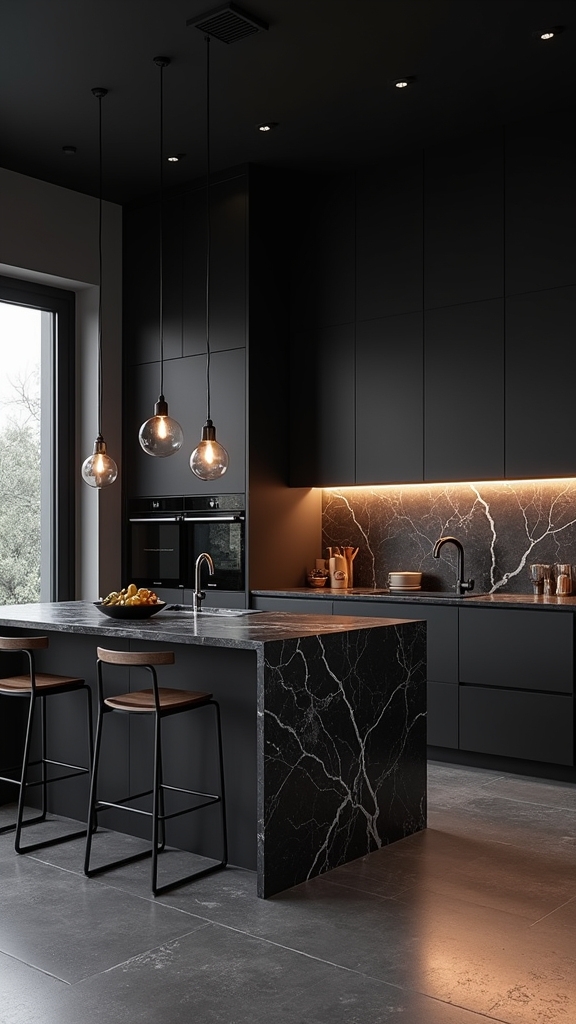
A distinct subset of contemporary kitchen design, custom minimalist black kitchens prioritize spatial clarity through the use of streamlined matte cabinetry, integrated appliances, and unobtrusive hardware.
Modern cabinetry in a matte black finish delivers a visually striking yet understated effect, emphasizing geometric precision and eliminating visual clutter. Integrated appliances and open shelving extend the linear flow, supporting a sense of openness and maximizing usable space.
Tailored cabinetry solutions facilitate the selection of unique finishes and hardware, enabling a personalized yet cohesive appearance.
Lighting design is integral: under-cabinet LED strips and minimalist pendant fixtures introduce layered luminosity, subtly articulating surfaces and enhancing depth.
High-gloss finishes, by harnessing natural and artificial light, can enhance the overall spatial perception in the design.
The result is an environment where every element—matte black cabinetry, spatial efficiency, and precise details—contributes to a moody, modern atmosphere free from superfluous ornamentation.
DIY Backsplash Ideas
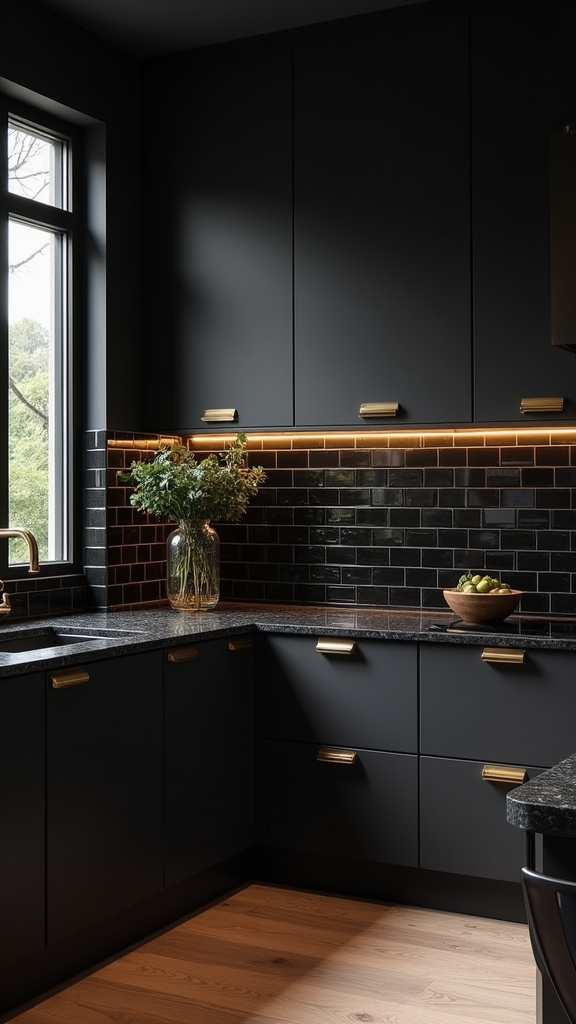
When designing a black kitchen, implementing a DIY backsplash offers an opportunity to introduce custom visual and textural elements that reinforce the overall aesthetic.
The integration of materials such as plywood, ceramic tile, and reclaimed wood enables homeowners to align spatial surfaces with black cabinetry, emphasizing modernity and depth.
Utilizing a black wood stain on a plywood backsplash accentuates the grain, creating a cohesive interaction with minimalist design principles.
For those seeking functional artistry, chalkboard paint transforms the backsplash area into a writable surface, enhancing both utility and creativity.
Geometric compositions with painted wood tiles allow for modular patterning that enhances the kitchen’s spatial rhythm.
- Black-stained plywood showcasing natural wood grain
- Textured ceramic tile installations
- Reclaimed wood for organic contrast
- Chalkboard paint for dynamic, changeable surfaces
- Painted wood tiles in geometric arrangements
Teal and Black Combinations
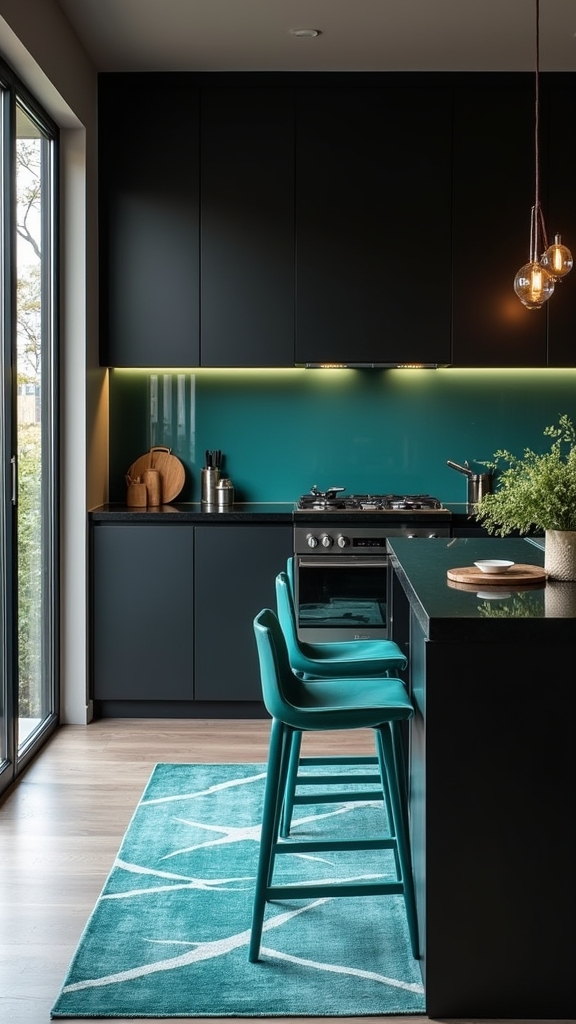
Following the exploration of custom backsplash solutions, the interplay between teal and black emerges as a compelling chromatic strategy for kitchen environments. This juxtaposition enhances black kitchen ideas by infusing vivid tonal contrast and spatial definition.
Teal can be integrated through modern cabinetry, accent walls, or high-gloss appliances, establishing a dynamic focal point against matte or satin black surfaces. Calacatta marble countertops introduce visual relief, their veining softening the overall composition while maintaining a contemporary edge.
In French-inspired layouts, the layering of bold hues and tactile textures enriches the culinary workspace, promoting both sophistication and individuality. The strategic use of a multicolored rug, particularly one incorporating teal, further animates the floor plane, generating movement and depth within the spatial envelope.
Brass and Black Pairings
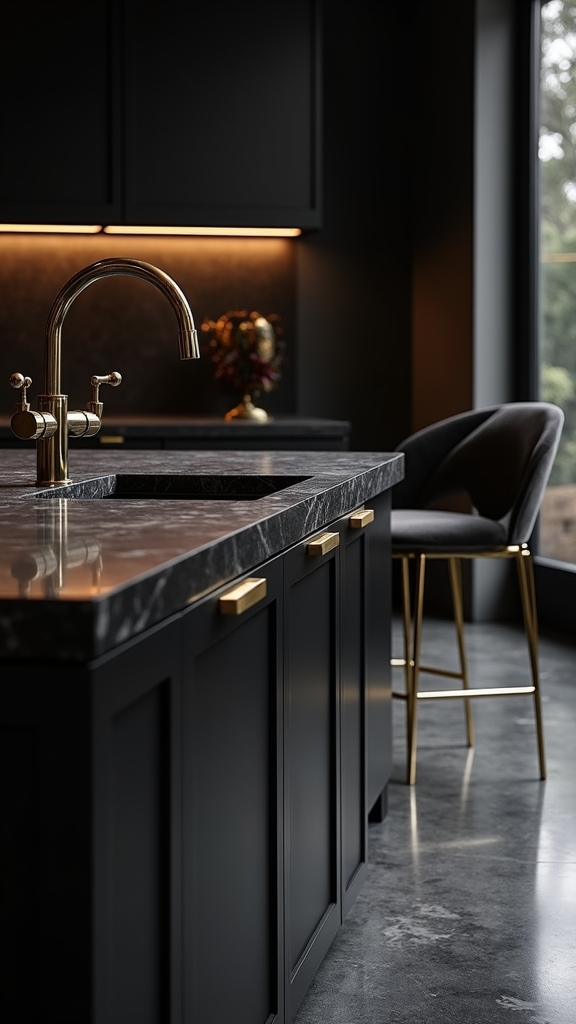
Although often associated with stark minimalism, black kitchens achieve heightened dimensionality and warmth through the calculated introduction of brass elements.
The interplay between matte black cabinetry and polished brass accents generates a compelling juxtaposition, infusing spaces with both drama and sophistication. Brass hardware—ranging from pulls to knobs—adds tactile richness, while brass fixtures offer luminosity and visual anchors.
Matte black cabinetry paired with polished brass accents creates dramatic sophistication, adding tactile richness and luminous focal points to any kitchen.
This high-contrast approach not only establishes a contemporary aesthetic, but also cultivates an inviting, luxurious environment. The spatial rhythm of black cabinetry punctuated by radiant metallics aligns with 2025’s design preference for bold, modern contrasts.
Incorporating gold lighting fixtures in black kitchens can further enhance the overall elegance and charm by providing ambient lighting that complements the decor.
- Matte black cabinetry with sleek brass handles
- Polished brass faucets atop deep black sinks
- Brass pendant lighting above textured black islands
- Black open shelving with integrated brass brackets
- Subtle brass trim accentuating black drawer fronts
Floor-to-Ceiling Black Cabinets
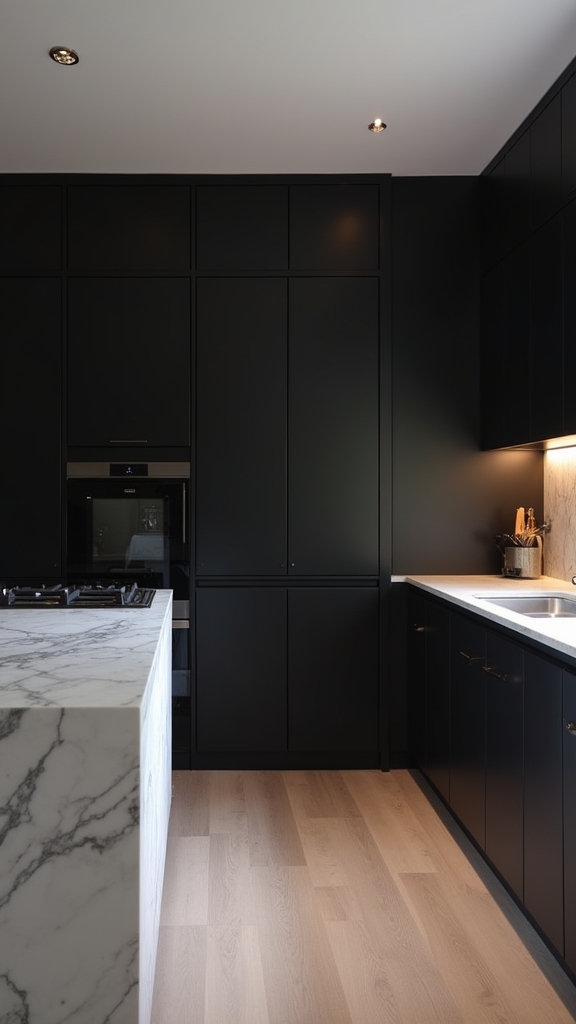
Monolithic expanses of floor-to-ceiling black cabinetry establish a commanding focal point, amplifying the kitchen’s verticality while unifying the visual plane. This design strategy optimizes spatial perception, enhancing the room’s sense of height and grandeur.
Floor-to-ceiling black cabinets maximize storage by utilizing the full wall, contributing to a seamless, cohesive envelope devoid of visual fragmentation. Modern cabinetry in black, whether rendered in matte or glossy finishes, introduces subtle textural differentiation and enables customization aligned with the homeowner’s aesthetic.
The integration of open shelving within this configuration disrupts the monochrome, providing visual relief and curated display zones for botanicals or objets d’art.
Floor-to-ceiling black cabinets function effectively in both moody and modern kitchen environments, offering adaptability across diverse stylistic narratives while maintaining architectural clarity.
Mixed Texture Layers

By thoughtfully integrating mixed texture layers, a black kitchen achieves heightened visual complexity and tactile dimension. The interplay of diverse materials—such as matte black cabinetry juxtaposed with glossy backsplashes or stone worktops—creates a visually dynamic environment. Textured surfaces like fluted cabinet doors and brushed metal taps add depth, while metallic hardware in brass or antique bronze establishes focal points against dark cabinetry. Layering organic elements, including wooden shelves or polished concrete islands, introduces warmth without compromising the modern, moody aesthetic. Each textural choice becomes a strategic design intervention, allowing for personalization and nuanced spatial experiences. Textured surfaces add depth and interest to the kitchen, enhancing visual appeal through tactile variety. Fluted black cabinetry paired with stone countertops, glossy ceramic backsplashes offsetting matte finishes, brushed brass hardware accentuating cabinet doors, wooden shelving for natural warmth, and polished concrete islands anchoring the composition.
Black and White Balance
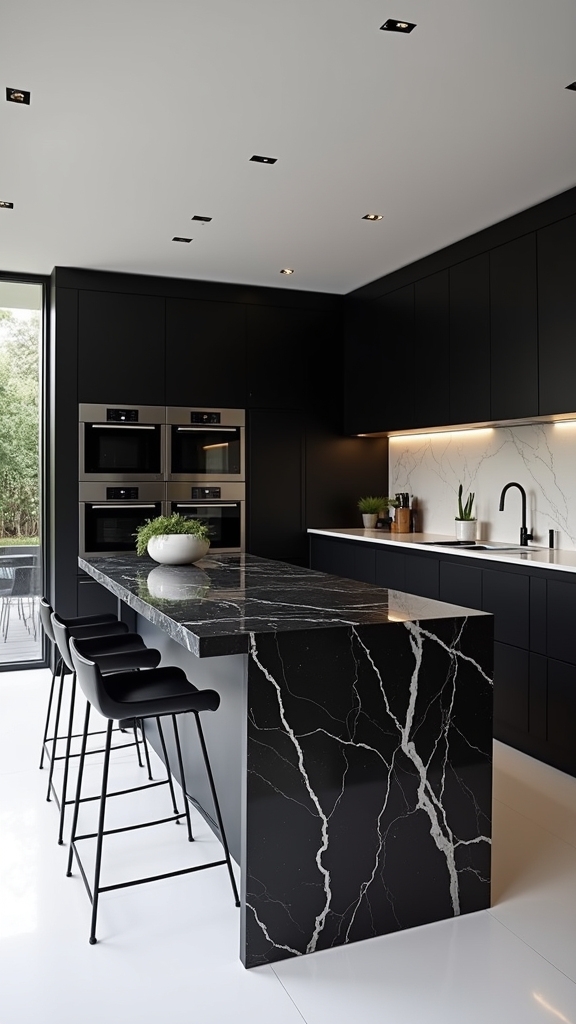
When executed with spatial precision, the interplay between black and white establishes a high-contrast framework that defines the kitchen’s architectural lines and volumetric relationships. Within this framework, black cabinetry serves as a visual anchor, while white marble countertops and backsplashes introduce luminosity and material variation, mitigating the potential heaviness of a monochromatic black scheme. The crisp delineation between black and white surfaces accentuates geometric boundaries, creating a visually dynamic yet harmonious environment. Integrating white elements, such as cabinetry fronts or streamlined light fixtures, injects brightness and softens the visual density of black-dominant zones. This calibrated distribution of contrasting tones not only underscores modernist tendencies but also enhances spatial clarity. The result is a balanced composition that invites further layering of textures and subtle accent hues. Adding natural wood accents can soften stark contrasts and infuse warmth into the space, complementing both white and off-white cabinetry.
Open Plan Black Kitchens
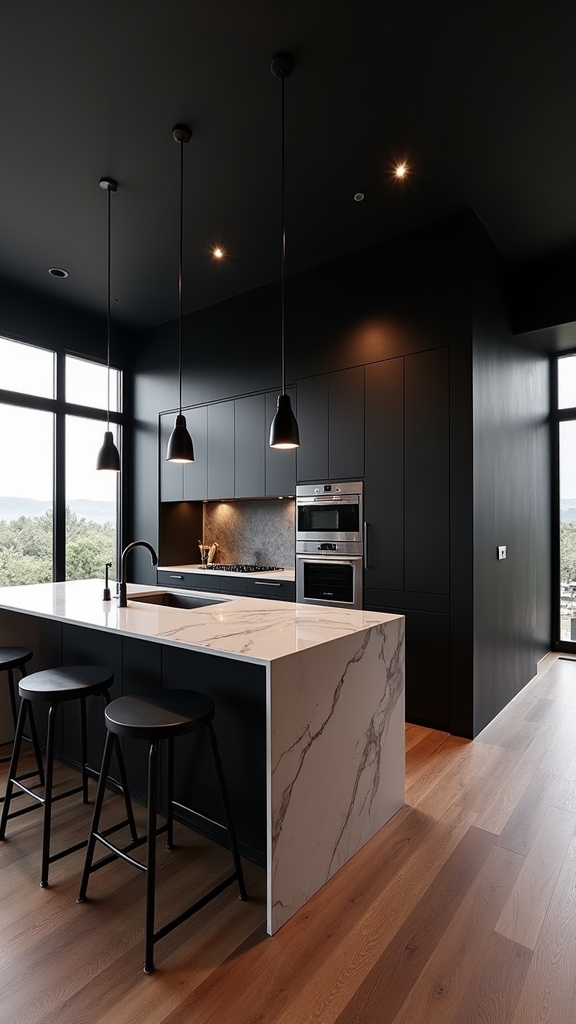
A significant proportion of contemporary interiors adopt open plan black kitchens to facilitate spatial continuity between culinary, dining, and living zones. This spatial strategy amplifies functional integration and enhances visual connectivity throughout the home.
The deployment of black kitchen cabinetry establishes a striking focal point, anchoring the zone while allowing for adaptable layering with light worktops or organic wood surfaces. Strategic illumination—via pendant fixtures or under-cabinet LEDs—ensures that the depth of black finishes maintains balance and ambiance instead of overwhelming the environment.
Large fenestrations, such as expansive windows or sliding glass doors, optimize daylight penetration, mitigating any potential heaviness.
- Matte black kitchen cabinetry set against pale stone countertops
- Open shelving displaying sculptural ceramics
- Integrated dining islands for seamless shift
- Pendant lights in metallic finishes
- Floor-to-ceiling windows for maximum daylight
Frequently Asked Questions
How Do You Keep a Black Kitchen From Feeling Too Dark or Closed In?
To prevent a kitchen from appearing overly dark or confined, designers recommend integrating advanced lighting solutions, such as layered illumination, and introducing strategic color accents. This enhances spatial perception and visually balances the predominance of darker surfaces within the environment.
What Cleaning Products Work Best for Maintaining Black Surfaces and Appliances?
When maintaining black surfaces and appliances, utilizing natural cleaners like diluted vinegar guarantees streak-free results, while specialized surface protectants prevent smudges and fingerprints. Consistent spatial awareness during application avoids residue build-up, preserving the visual clarity and reflective properties.
Are Black Kitchens More Prone to Showing Fingerprints or Dust?
When evaluating kitchen surfaces, black finishes often exhibit reduced fingerprint resistance, making smudges visually prominent. Dust visibility also increases due to high contrast against dark backgrounds, affecting spatial perception and necessitating frequent cleaning for ideal visual emphasis and cleanliness.
How Can You Incorporate Plants Into a Black Kitchen Aesthetic?
Incorporating plants utilizes hanging planters for vertical spatial optimization, introducing visual contrast against dark surfaces. Selecting low light plants, such as pothos or snake plant, guarantees botanical vitality while maintaining minimal interference with the kitchen’s functional workflow and aesthetic coherence.
What Types of Flooring Complement a Black Kitchen Without Overwhelming the Space?
When selecting flooring, hardwood flooring in lighter tones offers visual contrast and spatial expansion, preventing visual weight. Alternatively, ceramic tiles in neutral or patterned finishes maintain balance, introducing texture and emphasizing delineation between the kitchen’s surfaces and cabinetry.
Conclusion
Incorporating a black kitchen aesthetic leverages contrast, materiality, and spatial layering to deliver a visually striking, contemporary environment. From matte finishes to reflective surfaces, the interplay of light and shadow enhances spatial perception, while varied textures create depth. Strategic use of black—whether via cabinetry, accents, or flooring—anchors the design, producing both intimacy and expansiveness. Ultimately, modern black kitchens exemplify how thoughtful chromatic and textural choices can redefine spatial boundaries and amplify architectural character.
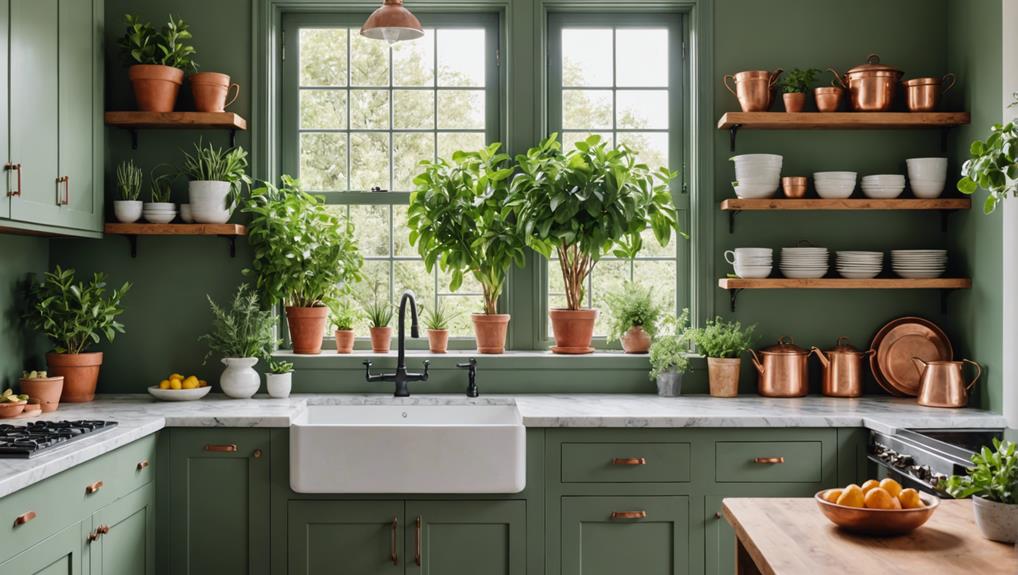

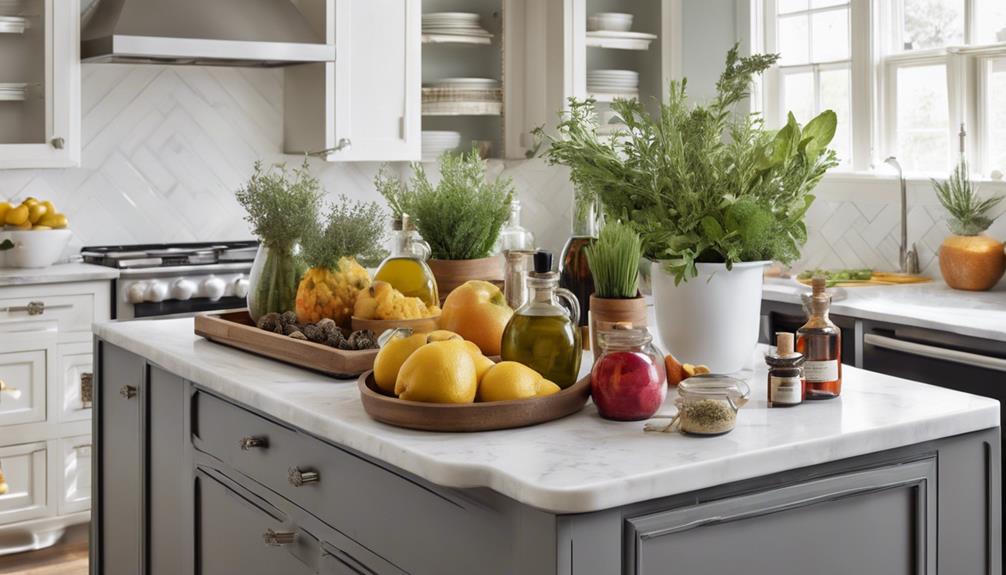
Leave a Reply